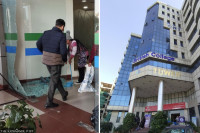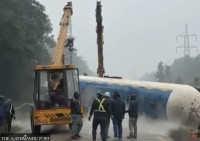National
Traditional brick kilns continue to pollute air, take life and cause huge financial loss: World Bank Report
Experts say Nepal, which has a smaller brick market compared to India and Bangladesh, can make transition to clean technology in a short span of time..jpg&w=900&height=601)
Chandan Kumar Mandal
Burning of low-grade coals and failure to upgrade to environment-friendly, advanced and efficient technologies have made brick kilns one of the major sectors contributing to air pollution in the country, according to a latest World Bank study.
The report has said brick kilns continue to emit harmful pollutants in the atmosphere and are responsible for hundreds of pollution-related deaths and causing huge financial burden on the country’s public health sector.
The report titled, “Dirty Stacks, High Stakes: An Overview of Brick Sector in South Asia”, which was released on Thursday, provides a comprehensive overview of the brick sector, its impact on air pollution and climate change in three countries – Bangladesh, India and Nepal.
The study has estimated that in the year of 2015, about 600 premature deaths were caused by pollution emanating from the brick sector. Furthermore, the associated Disability Adjusted Life Years (DALYs) were roughly 4,800 for Nepal. The economic cost on public health of the brick sector in Nepal, according to the study, is about $46 million per year.
The South Asia region, which produces 20 percent of global production of clay bricks, is also responsible for estimated 91 percent of the total emission of Particulate Matter, consisting mainly of suspended particulate matter (SPM), PM2.5 and PM10, in some South Asian cities. However, traditional kiln technologies namely the Fixed Chimney Kiln (FCK) and Zigzag Kiln (ZZK) are the most dominant ones in all three countries, according to the World Bank study.
In Nepal, where the current annual brick production stands at 4.9 billion units a year, the estimated annual emissions of SPM from the brick sector is 24,868 tonnes. Likewise, annual emission of sulphur dioxide stands at 42,839 tonnes, followed by PM10 (9,370 tonnes), PM2.5 (5,622 tonnes), black carbon (2,044 tonnes) and nitrogen oxide (872 tonnes).
As per the report, there are nearly 1,600 brick kilns operating in Nepal, burning approximately one million tonnes of coal every year. They emit 2.2 million tonnes of carbon dioxide (CO2), which is 37 percent of the country’s total CO2 emission.
In Kathmandu Valley, where only eight percent of the country’s total brick kilns are operating, the brick kilns are estimated to be responsible for approximately 28 percent of the total PM10 concentrations and contribute 40 percent of black carbon during the winter season, according to Prajwal Baral, one of the co-authors of the report.
“Besides various health issues caused by these pollutants, Black carbon, for instance, is also now understood to contribute to global climate change and other regional climate problems such as weakening monsoon and accelerated glacier melt,” Baral, who is a co-founder and managing partner of Hornfels Group Pvt Ltd, a Kathmandu based technology investment consultancy, told the Post.
These brick kilns release carbon dioxide, carbon monoxide, black carbon, and Particulate Matter. These pollutants, mainly the particulates (PM10 and PM2.5) can have detrimental effects on human health, causing a variety of respiratory complications such as lung cancer, asthma, chronic bronchitis, and emphysema; and cardiovascular and neurological problems. Children and pregnant women are particularly vulnerable to brick sector emissions.
“Despite such devastating impacts of brick sector-related pollution, Nepal has less than one percent market penetration of advanced and efficient technologies like Hoffman, Hybrid Hoffman and Tunnel Kiln,” said Baral.
Traditional brick kilns have low energy efficiency and are highly polluting, estimated to be consuming about 18–25 tonnes of coal to produce 100,000 bricks.
According to experts, in terms of air pollution, Mobile Chimney Kiln (MCK) and Fixed Chimney Kiln (FCK) are the most polluting technologies. Hybrid Hoffman Kiln (HHK) and Tunnel Kiln (TK) are considered to be the cleanest, whereas the Zigzag Kiln (ZZK) falls in between.
In Nepal, MCK and FCK are the most widely used technologies, although efforts are underway to switch from MCKs to FCKs and/or ZZKs with technical support from bilateral agencies, international NGOs and private sector experts, reported the study.
“Hoffman and Hybrid Hoffman Kiln are in insignificant numbers in Nepal, and TK is non-existent so far,” said Baral. “Both cost-benefit analysis and sensitivity tests done by the study suggest that HHK and TK should be the technologies of choice for all entrepreneurs if they are constructing new kilns.”
The study has concluded that although the brick kilns sector of these three countries faces challenges to modernisation and formalisation, and to the efficiency and pollution control, there are immense opportunities for improvement.
The study has recommended that recognising the importance of the sector; planning for long-term; raising awareness on energy consumption, emission factors, and health impacts of brick kilns; and promoting the social welfare of the brick workers and their families are bringing improvement in South Asia’s brick sector.
The study also points out that burning coals for brick production has only added extra pressure on the energy security, particularly for a country like Nepal with low domestic fuel reserve.
But the fact that Nepal has a rich deposit of other alternative construction materials offers an upside: the country could make transition to other building materials by adopting much cleaner technologies.
Experts say Nepal can make this transition since the country’s brick market is much smaller compared with India and Bangladesh.
Nepal could promote alternative walling materials, conduct more pilots on cleaner kiln technologies that fit the country’s context and improve the resilience of building materials to natural disasters, the World Bank study recommended.
“The sluggish reconstruction in the aftermath of the 2015 earthquake remains an opportunity for concerned stakeholders to accelerate the transition to cleaner and more efficient kiln technologies and redefine the brick market with new alternative products,” said Baral, the co-author of the report. “With the favourable policy and regulatory reforms in place in the Post 2015 earthquake scenario that brings down the cost of raw materials and incentivises property developers to use resource-efficient building materials like concrete blocks, Nepal could leapfrog from traditional brick kiln technologies to modern and alternate building materials in a very short span of time.”




 11.12°C Kathmandu
11.12°C Kathmandu













%20(1).jpg&w=300&height=200)

